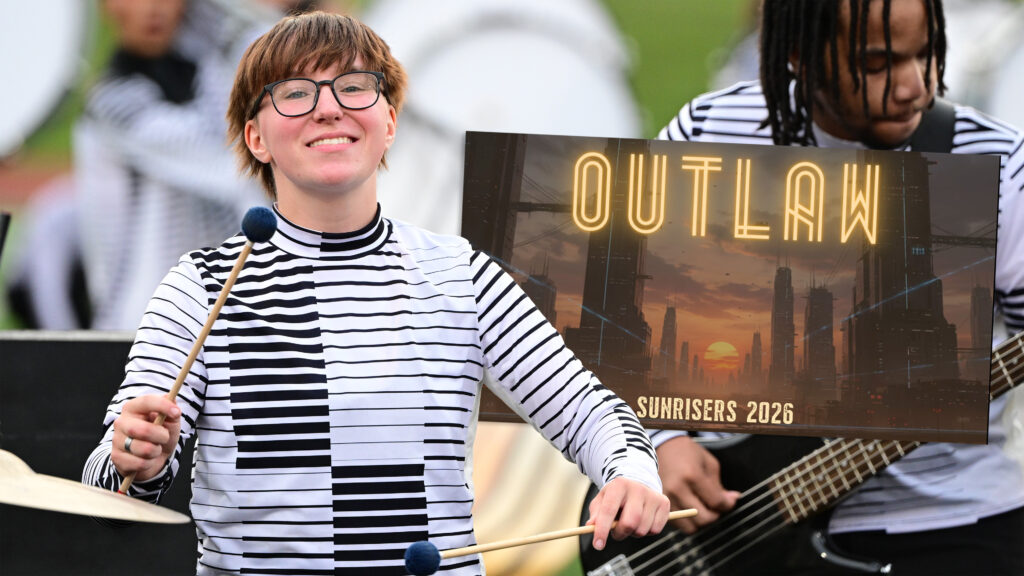Stephanie Lynde, the third woman inducted into the Drum Corps International Hall of Fame, recognized for ushering in a new style of color guard movement in the 1980s rooted in modern dance, died November 8. She was 66.
Confirmed by the Blue Devils, friend Jennifer Lynne Anderson reported her passing on Facebook.
Lynde got her start in the drum corps activity as a teenager in northern California, getting involved with the Blue Devils in 1970, the year the drum and bell corps added brass instruments and transitioned into a full-fledged drum and bugle corps. Competing with the group from 1971 to 1977, she rubbed shoulders with a number of notable names in the drum corps universe including Blue Devils founding director Jerry Seawright who she formed a particularly close bond with.

“He was a second father, a mentor, somebody that was trustworthy and committed. He was always true to his word,” Lynde said. “You always knew where he was coming from and he was an excellent role model in that way. It was a wonderful time to be in the corps with Jerry as director.”
Nurturing those close ties within the Blue Devils organization, Lynde made the leap from performer to instructor following her age-out drum corps season in 1977. She spent the next three years teaching the color guard of the Blue Devils “B” corps.
Lynde joined the staff of the Blue Devils “A” corps in 1981 as an instructor and choreographer at a time when she was just starting on a dance degree at the University of San Francisco. She worked with the Concord, California corps through 1989 while also dancing professionally in California.

Perhaps one of Lynde’s most memorable footnotes in the history of the 1980s Blue Devils color guards was the group’s use of fabric “wings.” Bringing a vision to life that went beyond the typical spinning of flags and rifles, Lynde’s new piece of equipment was inspired by turn-of-the-century modern dancer Loie Fuller and “engineered” by fellow Hall of Fame member Shirley Stratton Dorritie. It became an iconic way for the Blue Devils to fill the field with color and dynamic movement. As Lynde said, “it was a piece of pageantry equipment that really worked for us and is still working for many drum corps and bands.”
Known for a radiant smile and sharing her love and laughter with whoever she encountered, as a teacher, Lynde easily and meaningfully connected with her drum corps students.
“She combined strength, beauty, patience, passion, challenge, and joy as she taught so many of us with little ‘formal’ dance training to look beautiful and feel joyful as we moved in the studio, on the stage, or on the field,” former Blue Devils color guard member Tracie Root (Branch) wrote on Facebook.
“She was stubbornly passionate about her craft,” Blue Devils senior executive advisor David Gibbs posted in tribute to Lynde. “She poured her love into her students and connected with them like they were her own family. Fiercely protective. She built relationships that are forever bounded together by love.”
Tapping her experience in the professional dance world, Lynde ushered in a new era for drum corps visual performance. As she put it, she helped color guards appear more “sleek, feminine, flowing, and engaging.” It marked a drastic change from the stiff, militaristic roots of the drum corps activity, one in which the color guard section now moved more freely and worked to build emotion and a close personal connection with audiences.
“From the late ‘70s and certainly from there on out, there’s more of a connection (in performances), it has more of a Broadway feel to it, more of a dance performance to it where performers actually want to connect with their audience,” Lynde explained. “They want their audience to feel what they’re feeling. They want their audiences to leave with that kinetic feeling, that exhilaration of watching someone do this type of performance.”





